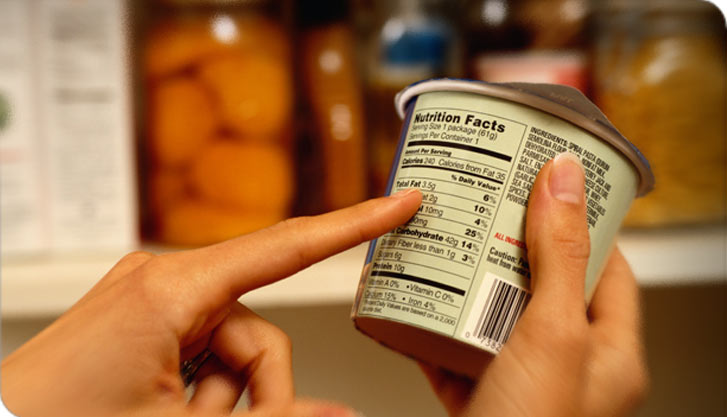Low-Fat, Fat-Free, All Natural, Low Sodium.
What do these words have in common?
These are all marketing terms that companies do research on in order to get you, the consumer, to buy their products. But here’s the catch, just because they say these things on the box, it doesn’t mean it’s any healthier for you. The truth is on the side panel or the back of box, typed in small print, Nutritional Facts.
The FDA gives a set of guidelines that are very broad in the rules of listing your nutritional facts. Because of this broad set of guidelines, nutritional facts are often altered in order to be labeled as low fat or fat free. In order for a product to be considered “low fat”, it must contain 3g or less per serving. So on the nutrition facts it’ll look like it is “low-fat” but what the company did was create a smaller serving size in order to make the requirement. Think of a cereal box, serving size is always 1cup, but in reality most people will have 2 cups. So the actual intake of calories, fat, carbs and protein is doubled. But when you are at the store and look at the serving size, you think ‘Oh, that’s not bad.’
It truly makes things difficult when you are trying to eat healthy and companies take advantage of the broad spectrum of rules from the FDA guidelines.
Reduced Fat is more confusing than Low Fat. If a product has 25% less fat than a product that is close to comparison, it can be labeled as reduced fat.
Light/Lite is labeled on products that have 50% less fat or 1/3 fewer calories than the regular product.
Let’s use the Light/Lite claim on a jar of “Light” mayonnaise.
Regular Mayo
11g Fat
100 calories per serving
Light Mayo
5g Fat
50 calories per serving
The fat calories in the so-called light mayo still account for 45 (or 90%) of the 50 calories. 1g Fat = 9 calories. Do the math on the light mayo and you can see that 5g Fat = 45 calories.
So is the light mayo really better for you? No way, not when 45 of the 50 calories comes from FAT! In my opinion you’re better off not having it at all, since the recommended fat intake for one day is >18g. That teaspoon of light mayo is 27% of your daily intake! Yikes! Mayo is just a condiment!!
Here are 3 things to look at as you’re learning.
Calories
When looking at calories, be sure to also check the serving size. Calories may be low but it could be because the serving size is unreasonable. For example, almonds. Calories may be 100 but serving size is 14. Have you ever tried to eat 14 almonds? It’s tough.
Calories from Fat- This is a tell-all factoid on the label. 1g Fat = 9 calories so using the light mayo, we do the math and see that 5g Fat = 45 calories. Each serving size is 50 calories.
Macronutrients: Protein, Fat & Carb/Sugars
Protein- Recommended intake for the average person is 0.36g of protein per pound of body weight. (Exercising adults do need more.)
Fat- We already know the suggested amount is less than 18g.
Carbs/Sugars- The reason I suggest looking at both is because the sugar content will help you determine if the carbs are “good” or “bad”. If the sugar content is 23g and the Total Carbohydrate is 28g, you know it’s probably not all that good for you!
Sodium
Most processed foods will have salt in them to preserve their shelf life. Be aware that the recommended sodium intake per day is 2000mg. (FYI that’s less than 1 Big Mac Meal at McDonald’s which is 2600mg)
The truth is, don’t buy food based on the promises the companies make on the front of the product. Take the time to flip it around and read the Nutrition Facts.
Thankfully, this week the FDA announced long overdue updates to regulations on these confusing Nutrition Facts labels. You can read the press release here.
As stated by First Lady Michelle Obama, “Our guiding principle here is very simple: that you as a parent and a consumer should be able to walk into your local grocery store, pick up an item off the shelf, and be able to tell whether it’s good for your family…” I love the proposed changes. I love that they are trying to simplify the most important part of the packaging.
Here are some of the key changes:
- Serving sizes will reflect how much people really eat, not on what people “should” be eating.
- Highlight key sections of the labels such as calories and serving sizes.
- Require information about the amount of “added sugars” in a food product.
- Require the declaration of potassium and vitamin D
- “Calories from Fat” would be removed.
 Believe it or not, the nutrition facts have only been required on packaging in the last 20 years. The only real noticeable changes were made in 2006 when information on trans fat had to be declared on the label. It amazes me that it has taken the FDA this long to make these changes because recommended dietary intakes change as more and more research is done. Nevertheless, I’m glad that they are making the necessary changes. I believe that the consumer will only benefit and learn that eating healthy is not difficult if you know what you are looking at!
Believe it or not, the nutrition facts have only been required on packaging in the last 20 years. The only real noticeable changes were made in 2006 when information on trans fat had to be declared on the label. It amazes me that it has taken the FDA this long to make these changes because recommended dietary intakes change as more and more research is done. Nevertheless, I’m glad that they are making the necessary changes. I believe that the consumer will only benefit and learn that eating healthy is not difficult if you know what you are looking at!

